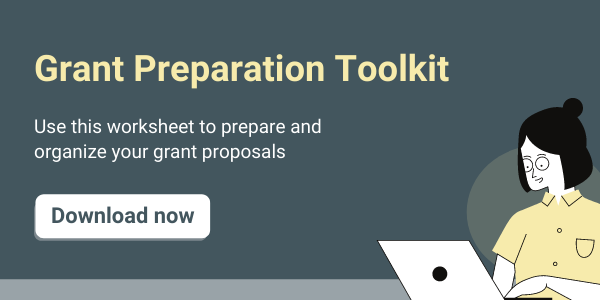Experienced nonprofit professionals are likely very familiar with various grant systems and programs.
However, for those entering the sector, or even trying out a new role, it can feel very overwhelming and confusing.
So let’s break it down: What exactly are grants and how do we find them?
What are Nonprofit Grants?
Grants, and by extension, grant writing is the process of applying for funding from foundations, corporations, government bodies, or community organizations. These can take various forms, from the offering of in-kind services, to credits to a particular vendor, to simple funding. Generally, they can be categorized by the type of institution providing the funds: government grants (federal, provincial, or municipal), foundation grants, and corporate grants.
Essentially, it’s money (restricted to certain activities or unrestricted) that could help fund your nonprofit’s next big initiative. In fact, many nonprofits rely on grant funding to seed any new initiatives and even to support their core operating costs. Most grants typically focus on supporting a particular function or project, rather than an organization as a whole, so specificity is key!
How Do You Find Grants?
How you find grants will often depend on your type of organization, and your geographical location.
A good place to start is always your local community foundation. Most will have a breakdown of the list of programs they are currently supporting, as well as their recent grants.
To stay on top of what’s happening in the grants space, it’s a good idea to set up Google Alerts so you don’t miss any new funding news or new programs that are starting. Some suggestions for keywords you can set up are:
- Grant Support
- Grant Writing
- Grant/Grants
- Funding Opportunities
- Grant Applications
The list goes on.
Another key method is to use a trusted grants directory. Some directories are available for free for nonprofits, and others come with a small fee. A directory like Grant Connect offers the ability to subscribe month to month or to use a limited version for free at local libraries and resource centres across Canada. Additionally, signing up for foundation emails lists can also be helpful to discover when they announce new programs and funding your organization may be eligible for.
Lastly, finding community groups online or in-person for grant writing professionals can be a very helpful resource to share upcoming grants, so perhaps take a look in your area, or consider starting your own!
Writing Your Grant Proposal
Now that you know where to find grant opportunities, it’s time to actually secure the funding.
In order to be awarded a particular grant, your nonprofit or community organization must craft an application or proposal. This outlines not only how you will use the funds, but how it will impact your organization and the communities you support if you were to receive them. Proposals are the key to success here.
So, what’s important to include?
Consider Your Audience
When crafting your proposal, it is key to consider who will be evaluating it. For example, when applying for a government grant, it’s important to remember the grant will be larger in dollar amount but they will ask for very detailed information about how those funds will be used, budgets for your project, and long-term impacts, as government grants are publicly sourced from tax dollars.
When applying for a corporate grant, it may be valuable to focus on the narrative of your organization and focus heavily on community impact and your various ties to the areas where their employees live and work.
If you’re ever unsure about the audience you’re writing for, it’s helpful to set up a call or meeting with the funder to learn more about their interests, the types of projects they’ve previously funded, and important items to include in your application. Many funders also list their previously funded projects online, which can be a helpful resource to review when preparing your own grant application.
Lastly, regardless of the type of funder, always, always, always review and follow their application preferences and guidelines before proceeding with your grant application. Remember that grantmakers receive thousands of requests each year. Most applications are rejected simply because they weren't eligible in the first place or they didn't adhere to application guidelines.
What Are You Really Trying to Say?
Much like other forms of writing, it’s necessary to develop a coherent narrative you’re attempting to convey to the grantmaker. Less is more with grant writing, and including too many details not related to your project may confuse the reader, and may infer that the project is not yet ready for funding.
A helpful tip for getting started is to work within a worksheet to develop your arguments and key pieces of information to include.
In your proposal, every item you include should be directly related to your organization, the initiative you’re requesting funding for, the funding preferences of the grantmaker, and should be working to further the point of why your organization is deserving of this grant.
Every item included should not only work in the scope of your project, but should work hard to deliver the message and impact that your project will have.
Data, Data, Data
Within your nonprofit or community organization, you likely already have access to many statistics, case studies, and impact reports by virtue of your organization's annual report. By including data points and case studies in your application, you can provide real-world examples of the ways in which your organization contributes to the community around you.
Using these figures not only shows the value of your organization, but also your organization's ability to report on the impact made in your community. All of these factors become very important after a grant has been approved, particularly in the reporting and stewardship process. You’ll need to prove you spent the money as outlined in your proposal, demonstrating the impact the funding had on your organization’s work.
Grantors are always happy to see an organization that is prepared and organized with their data, but be careful not to overwhelm the reader with too many facts or statistics. Ensure your data points have impact and purpose by evaluating if they are directly related to your proposal, and are easily explained.
Don’t Forget to Proof Read!
The downfall of many great grant applications lies in the details. It is always important to have a second set of eyes on your application to ensure that the messaging is clear, the data is relevant, and the importance of the cause hits close to home.
Having a dedicated proofreading partner can be very helpful, and allow for additional thoughts and insights into your application. If you don’t have access to a proofreader, try Grammarly for additional support in proofreading, grammar, syntax, and overall clarity.
Lastly, a helpful trick I always recommend to writers is running your application through an audio service, or Google Translate reading feature! You are much more likely to catch errors or clunky phrases upon hearing it out loud, and this method is especially helpful to those without a second pair of eyes to review.
If you need help gathering your thoughts before you begin your proposal, fill out our Grant Preparation Toolkit. There are persuasive writing tips to get you started.
Guest contributions represent the personal opinions and insights of the authors and may not reflect the views or opinions of Imagine Canada.
Delainey Lockett is an organizational fiend, who is passionate about process and policy. When she's not putting out fires at work, she's teaching others how to make them through volunteering as a leader for Girl Guides of Canada. She is a Sales Administration Specialist at Keela, a Canadian Donor Management Software (CRM) that gives you powerful tools to engage with your donors, mobilize your volunteers and market your nonprofit. As the only CRM with fundraising intelligence tools, Keela will help you raise more money.





